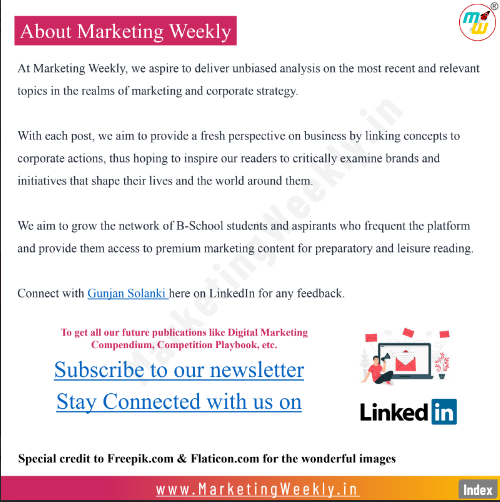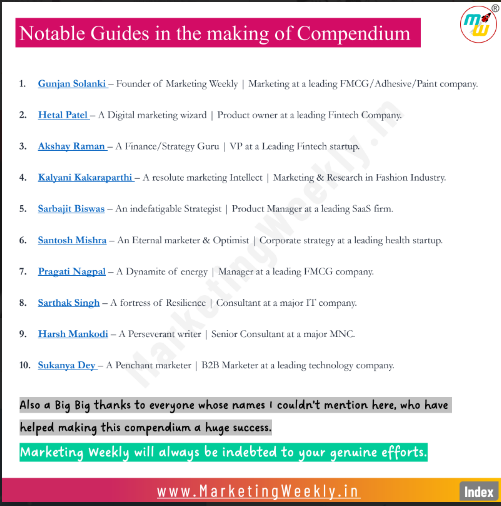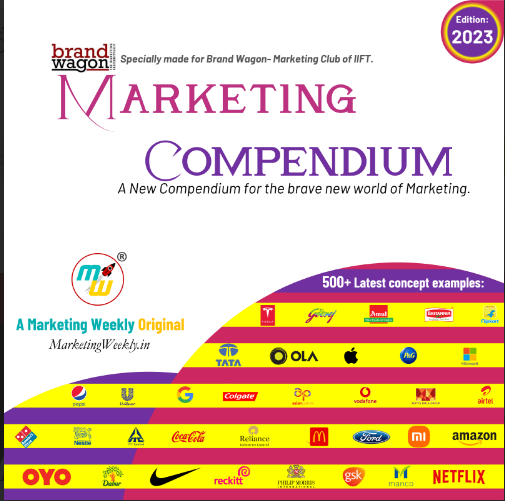


brand
wagon
®
marketing
Specialty made for Brand Wagon – Marketing Club of IIFT.
COMPENDIUM
A New Compendium for the brave new world of Marketing.
MW
®
A Marketing Weekly Original
MarketingWeekly.in
500+ Latest concept examples:
Edition:
2023
(Logos/Text from the strip of companies are not fully legible, but some identifiable ones are:
TATA, OLA, Apple, Airtel,
Pepsi, Colgate, Vodafone, HDFC Bank
Coca-Cola, Reliance, Ford, Mi, Amazon
OYO, Dabur, Nike, Reckitt, HUL, Netflix)
About Marketing Weekly
At Marketing Weekly, we aspire to deliver unbiased analysis on the most recent and relevant topics in the realms of marketing and corporate strategy.
With each post, we aim to provide a fresh perspective on business by linking concepts to corporate actions, thus hoping to inspire our readers to critically examine brands and initiatives that shape their lives and the world around them.
We aim to grow the
Introduction to MARKETING
Marketing is meeting consumer demands profitably. It starts by identifying a gap in the Market – something for which there is an inert need/want that isn’t sufficiently met.
Marketing works its way from here to build a product or a service that meets those needs and wants.
Marketing covers broad areas ranging from finding the right Target Group (TG) to pricing and communication strategies.
For now, Understand that a successful marketing execution brings prospects to you (it’s a Pull strategy).
(Hình ảnh Apple iTunes Store và nam châm)
A great example of identifying gaps in the Market is Apple’s iTunes. iTunes changed the music industry by making it possible for customers to own thousands
Place:
So how does a product move from the place of production to the place of consumption?
The place is basically the channel of distribution a company chooses to increase the reach of its products.
Below are major channels that are used to facilitate distribution:
• Direct Sales: Door to door, Selling at the Manufacturer’s Plant
• Indirect Channel: One-Level Channel, Hybrid Distribution Channel, or Multi-Channel Distribution System.
• Ecommerce
Promotions:
How does a new product reach people? It begins with the inception of the new product idea; the price is fixed and then the product is distributed…..but how will people know about it? Promotions play a major role in increasing the awareness of the product. Promotion helps in increasing brand/product awareness and in lead generations. Marketing campaigns include promotional activities to engage and attract consumers.
There are two types of Promotions:
☐ Sales Promotion: Bundle offers, Discounts, BTL activities, etc.
☐ Marketing Promotions: Digital Campaigns, Sponsorships, etc.
The Remaining 3 Ps of the 7P:
People:
The people in the framework represent the employees, consultants, and freelancers who deliver the service to customers.
People are the most critical factor in providing knowledge-based services as they add value to the experience of the consumer.
Hence, training, personal selling, and customer service are key ways to ensure good service from the employees facing consumers.
E.g., Waiters of a restaurant, Hairstylists in a Salon, business analysts in IT companies, etc.
Process:
The processes are the steps that are required to deliver the service to a customer.
The aim of all service companies is to have a seamless process flow, making it easier for the consumer.
These companies share process maps for employees to make sure that work is repeatable and successful.
Segmentation:
• Segmentation is a practice that seeks out pieces of the total market that contain customers with identifiable characteristics, as defined by income, age, personal interests, ethnic background, special needs, and so forth.
• The point of segmentation is to break a mass market into submarkets of customers who have common needs.
Why do we need segmentation?
Not all individuals have similar needs. Individuals have different needs based on various factors which define them or their lifestyles like needs of men, women, and kids differ from each other completely, or the needs of married individuals would differ from bachelors or needs of people from different countries will be different, when they are to be satisfied using various products and services.
Identifying these segments makes it possible to do two things:
(1) Create goods and services that are better tailored to the needs of specific customers.
(2) Focus on marketing resources more efficiently.
MSADA Framework:
Market segments must rate favorably on five key criteria (MSADA) for them to be useful:
• Measurable: The size, characteristics & purchasing power of the segments can be measured.
• Substantial: The segments are large and profitable enough to serve. A segment should be the largest possible homogeneous group worth going after with a tailored marketing program.
• Accessible: The segments can be effectively reached and served.
• Differentiable: The segments are conceptually distinguishable and respond differently to different marketing-mix elements and programs.
• Actionable: Effective programs can be formulated to attract and serve segments.
Complete table for Segmentation:
| Segmentation variable | Sr. no | Basis of Segmentation | Example |
| Geographic | 1 | Regions – North, South, East, West | |
| 2 | City or metro size | Urban, Suburban, Rural | |
| 3 | Density | Urban, Suburban, Rural | |
| 4 | Climate | Hot, Cold, Tropical | |
| Demographic | 5 | Age | Under 5, 5-11, 12-17, 18-34, 35-49, 50-64, 64+ |
| 6 | Family size | 1-2, 3, 4, 5+ | |
| 7 | Family life cycle | Young, Single, Young married, No children married, youngest child below 6 | |
| 8 | Gender | Female, Male, Transgender | |
| 9 | Income | Under $10,000, $10,000-15,000 and so on | |
| 10 | Occupation | Profession, technical, Managers etc. | |
| 11 | Education | Grade school or less, graduate, post-graduate | |
| 12 | Religion | Hindu, Muslim, Christian, Sikh, Jain, Atheist. | |
| 13 | Race | White, Brown, Tribals | |
| 14 | Generation | Gen X, Millennials (Gen Y) | |
| 15 | Nationality | Indian, South African, American | |
| 16 | Social class | Lower, Middle, Upper | |
| Psychographic | 17 | Psychographic lifestyle | Culture-oriented, sports-oriented, outdoor-oriented |
| 18 | Personality | Compulsive, gregarious, authoritarian, ambitious | |
| Behavioural | 19 | Behavioural occasions | Regular occasion, Special occasion |
| 20 | Benefits | Quality, service, economy, speed | |
| 21 | User status | Non-user, ex-user, potential user, first time user | |
| 22 | Usage rate | Light user, medium user, heavy user | |
| 23 | Loyalty status | None, medium, strong, absolute | |
| 24 | Readiness stage | Unaware, informed, interested, desirous, intended to buy | |
| 25 | Attitude toward product | Enthusiastic, positive, indifferent, negative, hostile |
About Marriott’s Segmentation:
Courtyard by Marriott® hotels focus on travelers on the road, who want a nice, clean place to stay during their trip.
Ritz-Carlton® hotels target those who don’t mind paying a premium for luxury.
Marriott ExecuStay® hotels are aimed at professionals who need a long-term & comfortable place to stay.
Marriott International doesn’t communicate the same marketing message to all its customers.
Each hotel is designed and positioned to appeal to the unique wants and needs of a specific group.


